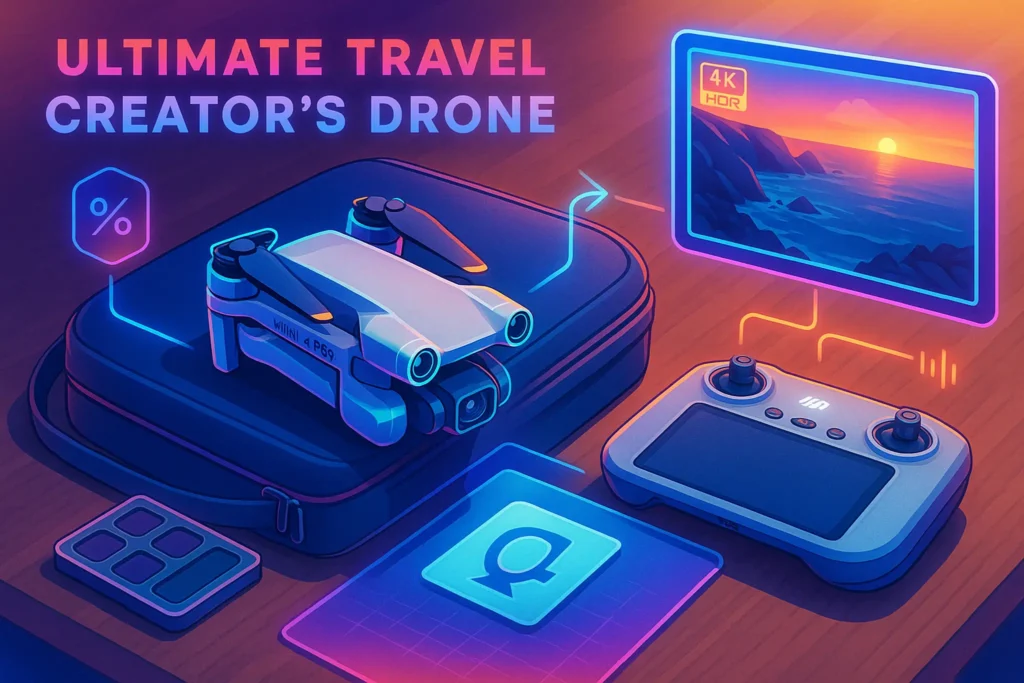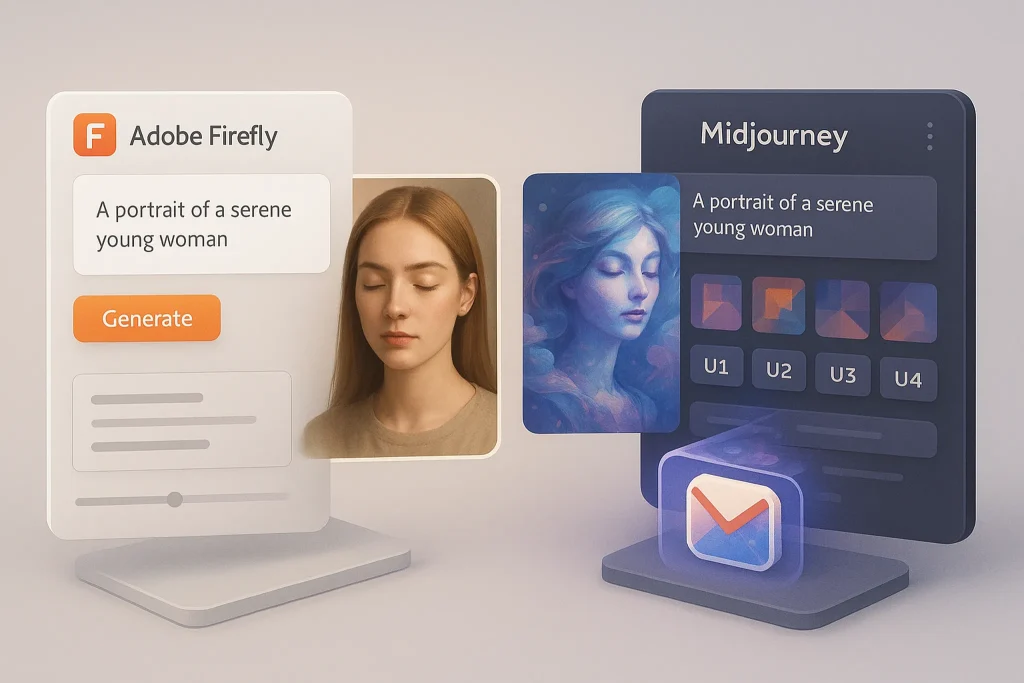🧭 Who this review is for (and what we tested)
If you’re a travel vlogger, solo creator, real-estate shooter, or a beginner who needs a portable, regulation-friendly drone that “just works,” the DJI Mini 4 Pro reads like a wish list: sub-249 g takeoff weight, omnidirectional obstacle sensing, ActiveTrack 360°, O4 transmission, 4K HDR and 10-bit color profiles (D-Log M, HLG), plus true vertical video for Shorts/Reels. On paper it’s a big leap over the Mini 3 Pro and a practical alternative to the heavier Air 3. In practice, it’s even more creator-friendly than the spec sheet suggests.
If your kit already includes action cameras and a lightweight editing laptop, this drone slots neatly between your camera bag and your timeline. In fact, the way Mini 4 Pro footage grades alongside clips from our GoPro Hero 12 Review for Travel Vloggers and renders smoothly on the MacBook Air M3 Review for Digital Nomads is a big part of why it’s attractive to creators traveling light.
💬 Your audience doesn’t care how big your drone is—only whether the shot looks stable, clean, and on-brand.
🎥 Image quality & color: small sensor, big results
At the heart of the Mini 4 Pro is a 1/1.3-inch 48 MP CMOS sensor paired with an f/1.7 lens. It records 4K HDR up to 60 fps, supports 4K/100 fps slow-motion, and offers 10-bit D-Log M and HLG for flexible grading across platforms. True Vertical Shooting rotates the gimbal for native portrait framing—no cropping, no lost resolution. These are creator-grade features that used to be “bigger-drone only.”
What matters more than numbers is how footage behaves. The Mini 4 Pro’s HDR pipeline keeps sky highlights tame while pulling detail from shadowy city streets; the Night Shots mode (paired with noise reduction) avoids the crunchy, over-sharpened look that plagued older minis. If you grade, 10-bit D-Log M gives you enough latitude to match camera A (a mirrorless) or GoPro Hero 12 B-roll with minimal fuss. If you don’t grade, HLG makes bright, punchy output ready for modern HDR screens and still looks fine on SDR after platform conversion.
Practical color tip: shoot D-Log M at daybreak and golden hour when you’ll want soft roll-off, switch to HLG for midday “run-and-gun,” and keep Standard for quick social cuts. Then lean on your editor—if you use one of the Best AI Video Editors for Non-Technical Creators, let AI handle scene-by-scene exposure matching before you apply a final LUT.
🧠 Safety, tracking & transmission: fly more, worry less
The headline upgrade you feel is omnidirectional obstacle sensing. The Mini 4 Pro watches in every direction (forwards, backwards, sideways, up, and down) and feeds this to APAS and braking/bypass logic. In the field, that means tighter tracking around trees and fewer “I almost clipped that cable” moments. For solo creators, ActiveTrack 360° with the new Manual Mode lets you pick a subject, draw a path around them, and let the drone circle smoothly while maintaining separation—great for walking pieces to camera or cycling shots.
DJI’s O4 transmission is also a quality-of-life win: a crisp 1080p/60 fps live feed up to a quoted 20 km (FCC) means your framing stays usable longer and you can trust composition when the drone rounds a corner. You obviously won’t fly that far, but the headroom translates to stronger signal in normal urban travel where interference can ruin a take.
Finally, the Advanced Return-to-Home logic (with obstacle awareness) and Waypoint Flight/Cruise Control bring the “bigger-drone” conveniences to a pocketable body. Set a path at sunset, lock exposure, and let it repeat the move for time-separated cuts—perfect for storytelling across days.
💬 Pre-draw a safety arc around yourself in ActiveTrack 360°, then walk your route once without recording to confirm line-of-sight and height.
🛫 Flight time, wind handling & batteries
With the standard Intelligent Flight Battery, expect up to 34 minutes in ideal conditions; with the Intelligent Flight Battery Plus, you can push to around 45 minutes—though note that the Plus battery increases takeoff weight above the sub-249 g threshold in many regions. If you travel for shoots, the Fly More bundle (three batteries, charging hub) is worth it; hopscotching locations without waiting on a wall outlet is real freedom.
Wind resistance? It’s good for its size, but physics is physics. The Mini 4 Pro is stable in light coastal winds; raise your frame rate (or shutter) and it will punch in gusts, but expect horizon micro-corrections you rarely see on heavier aircraft. When conditions worsen, you’ll appreciate the Air 3’s extra mass and 46-minute stamina—at the cost of weight and bag space.
Battery reality check: plan for 3 batteries minimum on active days; set the app’s low-battery RTH conservatively; and budget wind tax (gusty days eat minutes). If you’re the type who schedules sunrise content before a city walking tour, the standard pack is fine; if you’re also doing a sunset reveal, upgrade.
🧰 App experience & creator workflow
The DJI Fly app is beginner-friendly but deep enough for growth. You’ll find MasterShots, QuickShots, Hyperlapse, Waypoint, and Cruise Control alongside manual exposure and color profile control. The gimbal’s true vertical makes all your Shorts/Reels/TikTok planning feel natural—no reframing gymnastics later. Pair this with a light, creator-friendly editing setup (we ran tests on the MacBook Air M3), and you can cut 4K60 HDR day-of without breaking your back or your timeline.
If you want branded openers and lower-thirds fast, tools we compared in Canva vs Adobe Express for Small Business Design handle thumbnails and graphic elements that sit nicely atop D-Log-graded footage. For social distribution, consider connecting your email capture flow to Best AI-Powered Chatbots for Lead Generation to nudge viewers from “liked that shot” to “joined the list.”
🧪 Real-world use cases (and the settings that help)
✈️ Travel vlogging
For “walk into the view” reveals, set ActiveTrack 360°, pick Manual Mode, and draw a graceful half-orbital path that keeps your face in the lower-third. Shoot HLG 4K/60 for motion comfort and grade lightly. For golden-hour stillness, switch to D-Log M 4K/30, lock the exposure, and slide in with Cruise Control to keep speed constant.
🏠 Real-estate aerials
A gimbal-level, slow lateral slider at 3–5 m altitude sells scale. Use 4K/30 D-Log M, add ND filters to keep shutter near 1/60 for tastefully cinematic blur, and finish with a top-down roof scan for condition context. The Mini 4 Pro’s stable hover and obstacle sensing help in tight suburban lots.
🏄 Action sports (solo)
Track yourself on a bike path or beach run with ActiveTrack 360°; set a slightly higher altitude than you think (branches!) and choose 4K/60 for smoother motion. If you bring a GoPro mounted POV, the Mini 4 Pro’s color can be matched in post to maintain a coherent look across angles.
🎬 Solo creator B-roll
For city sequences, hunt for gentle parallax: frame a subject (coffee shop, mural), then subtly arc left or right with Waypoint repeatability to do multiple passes at different times of day for narrative continuity.
✅ Pros (after living with it)
The Mini 4 Pro nails the trifecta: packability, safety, and image quality. The ability to take off almost anywhere, wrap a subject with ActiveTrack 360°, trust omnidirectional sensing in complex spaces, and bring back 4K HDR or 10-bit footage is enormous for solo travelers. Add O4 for a reliably crisp live view, and it becomes a drone you reach for first, not “only when conditions are perfect.”
In one paragraph: If the story matters more than the spec sheet, this is the first sub-250g drone that consistently feels like a creative tool, not a technical compromise.
❌ Cons (know these before you buy)
Every small drone trades mass for mobility. In stiff wind you’ll see horizon micro-corrections and a bit more “float” on lateral moves than on an Air 3. The 1/1.3-inch sensor is excellent for its class but still smaller than pro drones; you’ll notice more noise in truly low light. And while the Plus battery extends flight time handsomely, its weight can bump you out of the sub-249 g category for certain jurisdictions—check your local rules.
In one paragraph: It’s the best “always-with-you” drone, not the best “fight the wind at a cliff’s edge at blue hour” drone.
📬 Get the Mini 4 Pro Creator Presets (LUTs + Flight Cheats)
Join our free newsletter and grab a print-ready pack for faster field wins:
D-Log M & HLG base settings, ND filter quick table, ActiveTrack 360° path templates for walk-and-talks,
safe-return altitude checklist, and a color-match starter LUT for GoPro/Mirrorless ⇄ Mini 4 Pro.
🔐 100% privacy. No spam. Just practical drone tips and creator workflows from NerdChips.
🥊 Mini 4 Pro vs Mini 3 Pro vs Air 3 (creator-focused)
Before the table, here’s the big picture: compared to Mini 3 Pro, the Mini 4 Pro brings omnidirectional sensing, O4 transmission, 4K/100, and newer HDR/low-light logic. Compared to Air 3, it loses the dual-camera flexibility and punch-through wind stamina but wins on weight and regulatory simplicity.
📊 Feature snapshot (creator-relevant)
| Feature | Mini 3 Pro | Mini 4 Pro | Air 3 |
|---|---|---|---|
| Weight class | <249 g | <249 g (std battery) | ~720 g |
| Sensor | 1/1.3″ | 1/1.3″ (updated pipeline) | Dual 1/1.3″ (wide + 3x) |
| Max video | 4K/60 (HDR at 24–30) | 4K/60 HDR, 4K/100 slo-mo | Dual-cam 4K/60 HDR |
| Color | DCG HDR | 10-bit D-Log M/HLG + HDR | 10-bit profiles |
| Obstacle sensing | Tri-directional | Omnidirectional | Omnidirectional |
| Transmission | O3 | O4 (1080/60 up to 20 km) | O4 |
| Flight time (rated) | 34/47 (Plus) | 34/45 (Plus) | 46 |
| Vertical video | True vertical | True vertical | Crop (no true vertical) |
Sources: DJI spec pages and announcements.
Interpretation for creators: If you shoot travel reels and want maximum safety with minimal weight, Mini 4 Pro is the sweet spot. If you need optical compression and long, windy coastal shots, and you don’t mind carrying more, Air 3 earns its place with the dual camera and time-on-station.
🧪 “Is the Mini 4 Pro right for you?” (context first, checklist second)
The right question isn’t “Is it the best drone?”—it’s “Is it the best drone for how I shoot?” For creators who hike to locations, weave between city blocks, or work alone, reliability and repeatability beat raw specs. The Mini 4 Pro wins because it survives the real world: crowded promenades, unknown wind pockets around buildings, and 15-minute gaps between trains when you need to nail a reveal.
Quick readiness check after the explanation:
-
You value sub-249 g travel simplicity more than absolute wind punch.
-
You publish vertical and horizontal video regularly.
-
You want omnidirectional sensing and ActiveTrack 360° for solo moves.
-
You edit HDR or 10-bit and care about matching to mirrorless/GoPro footage.
-
Your typical shoot window is 2–3 batteries long; the Plus battery’s weight trade-off is acceptable where you fly.
🧩 Accessories & setup that make a difference
ND filters tame midday shutter speed and reduce flicker on water and rooftops. A fast U3/V30 microSD keeps 4K/100 reliable. A compact sling or crossbody case with battery loops speeds swaps; if you opt for RC 2/RC-N2 controllers, check your mounting options. For “leave the laptop at home” trips, pair the drone with a phone/tablet and an AI-assisted editor from our Best AI Video Editors for Non-Technical Creators—you’ll publish before the train pulls out.
💬 Tape a tiny white dot on your controller where your “safe return altitude” lives—set it before every new location.
🧾 Legal & practical notes (not legal advice)
Being under 249 g often exempts the Mini 4 Pro from certain registration requirements in regions like the US and UK, which is part of its appeal to casual and travel users. That said, local laws vary by country and city (and even by park), and features like Intelligent Flight Battery Plus may push weight above certain thresholds. Always verify rules where you fly, respect no-fly zones, and get permits when shooting commercial real estate. (See contemporary reviews noting the sub-249 g regulatory advantage for casual flyers.)
💰 Pricing & value (2025 context)
Prices shift with promos and bundles, but the Mini 4 Pro Fly More kits deliver the best experience-per-euro because batteries are your real bottleneck. If the Air 3 sits in your budget, ask yourself whether you’ll truly use both cameras and handle extra mass on every hike. If not, spend the difference on NDs, cards, and maybe a creator-friendly mic for ground-level A-roll to pair with your aerials.
🎯🧠 Nerd Picks for Mini 4 Pro
💡 Start smart, travel light. These essentials unlock longer flights, smoother motion, and faster turnarounds.
Choose the Fly More combo if you shoot multiple locations—batteries and hub save the day more than any extra spec.
Add air time and fewer compromises. Note: Plus may change regulatory weight class—check local rules before flying.
Keep shutter in check for cinematic blur and ensure 4K/100 writes without dropped frames. Your edit will thank you.
Faster swaps, safer transit, and fewer missed light windows. Your back and batteries will appreciate it.
🧠 Nerd Verdict
If you want the drone you’ll actually carry, the Mini 4 Pro is it. It brings big-drone confidence—omni sensing, ActiveTrack 360°, O4—to a sub-249 g body that’s ready for 4K HDR and 10-bit workflows. In difficult wind or specialized shoots, the Air 3 will out-muscle it. The rest of the time, the Mini 4 Pro quietly turns “I wish I had a drone shot here” into “done.”
❓ FAQ: Nerds Ask, We Answer
💬 Would You Bite?
Are you leaning Mini 4 Pro for portability or Air 3 for dual cameras and stamina?
Tell me your typical shoot (city, coast, mountains), and I’ll map the settings and accessories you actually need. 👇



